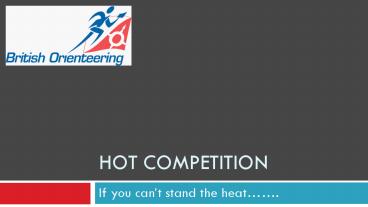hot competition PowerPoint PPT Presentation
1 / 13
Title: hot competition
1
hot competition
- If you cant stand the heat.
2
Performance Impairment
- Loss of fluid, as well as wider distribution
throughout the body of the already depleted fluid
volume means the heart has to work harder in
order to continue to supply the muscles and
organs with blood.
3
Dehydration
- 1-5 body mass loss due to dehydration
- 5-50 reduction in endurance performance 10-22
reduction in VO2max - Increases temperature due to decreased sweating
and cutaneous blood flow - 3.7 decrement in 1500m pace (6s), 6-7 decrement
in longer events - Benefits of heat acclimatisation are negated
- The risk of heat illness is increased
- (Armstrong et al 1985 Craig Cummings 1966
Pinchan et al, 1988)
From Rowell L B. Human circulation. Regulation
during physical stress. OUP, 1986.
4
Hyperthermia Central Fatigue
- There is a diminished central drive to exercise
in hyperthermic individuals - Cerebral blood flow falls due
- Hyperventilation
- Fall in CO and BP
- Brain temperature increases
- Brain sensitive to heat
- Affects cerebral cortex
- Nielsen Nybo, 2003)
5
Heat Performance
- Marathon performance declines 1 minute for each 1
C increase in air temperature above 15 C
(Maughan, ABC of Sports Med) - Compromised muscle and hepatic blood earlier
onset of anaerobic metabolism and blood lactate
accumulation - Muscle glycogen utilisation is increased fatigue
occurs earlier during prolonged moderate exercise
in the heat
6
Variables that affect response to heat
- Environmental conditions
- Body size (mass, skinfold thickness)
- State of training / sudden increase in tempo
- Degree of acclimatisation
- Hydration status
- Clothing worn
- State of Health fever, viral illness, cold, GI
disturbances
- Genetic profile responsiveness to heat
- Genetic disorders malignant hyperthermia
- Skin disorders - sunburn over 5 of body surface
impairs thermoregulation for 21days - Use of medication - diuretics, antihistamines
- Sweat gland dysfunction (e.g. prickly heat)
- Salt depletion
- Age
7
- Heat, Fitness Performance
- Aerobically fit individuals are able to perform
for longer in hot environments, and tolerate
higher levels of hyperthermia than less fit
individuals but - Abnormally high core temperatures impair exercise
performance in all individuals in the heat,
irrespective of fitness - Fatigue generally occurs with core temperatures
between 38 - 40 C (Hales et al, 1996 Nielson
et al 1997)
8
How to acclimatise
- Raise your body temperature to stimulate sweating
- This must be done in representative temperatures
(30-35C, 100min per day optimal) - It is important to exercise during these
exposures (but the mode is unimportant and
intermittent exercise is OK) - Acclimatisation is specific to the climate and
activity level i.e. The best would be to train in
the same conditions as you will experience on
race day.
- You should allow 10-14 days to acclimatise with
no more than 3 days elapsing between successive
exposures. 66-75 of changes occur in 4 to 6
days - Fitter individuals can acclimatise more quickly
(7-10 days) - Even fit individuals need to exercise in a hot
environment - On return to a temperate climate, the major
benefits are retained for a week, 75 are then
lost within 3 weeks
9
Acclimatisation
- Aldosterone secretion increases and increases
sodium chloride reabsorption in sweat ducts and
renal tubules. This results in lowered salt
content in sweat (e.g. sweat sodium reduced from
50 to 25mmol.L-1) and increased osmotic retention
of water, producing increased plasma volume - Increased sensitivity to aldosterone
- Less cardiovascular strain, perfusion pressure
better maintained - More effective distribution of cardiac output
- Improved cutaneous blood flow
- Earlier onset and greater rate of sweating
gland recruitment - Lower resting deep body temperature
- Lower skin and deep body temperatures for a given
level of exercise - Improved physical work capacity
- Increased comfort
- Decreased reliance on carbohydrate metabolism
10
Reducing the impact of the Environment
- Acclimatisation
- Hydration/Rehydration
- Cooling (Clothing, ice baths)
- Cooling stations fans, shade, source of cold
water drinks - Maintaining comfort (e.g. In accommodation, at
prestart, after the race) - Pacing strategy
11
Clothing
- Should be
- Lightweight
- Light in colour
- Breathable/open weave
- Loose
- Absorbent
- The main function of clothing should be to assist
the evaporation of sweat
12
WOC 2008 The Czech Republic
- The warmest month of the year in the Czech
Republic is July. On average, the summer
temperatures are about 20C higher than during
winter. Especially in the last decade,
temperatures above 30C are not unusual. Summer
is also characterized by rains and storms.
13
What is the heat stress in Czech?
- July Data
- Average High Temperature 22.2 C
- Average Low Temperature 12.2 C
- Average Mean Temp 17.2 C
- Average Morning Relative Humidity 81
- Average Afternoon Relative Humidity 54
- Record High 36.1 C
- Record Low 5 C

